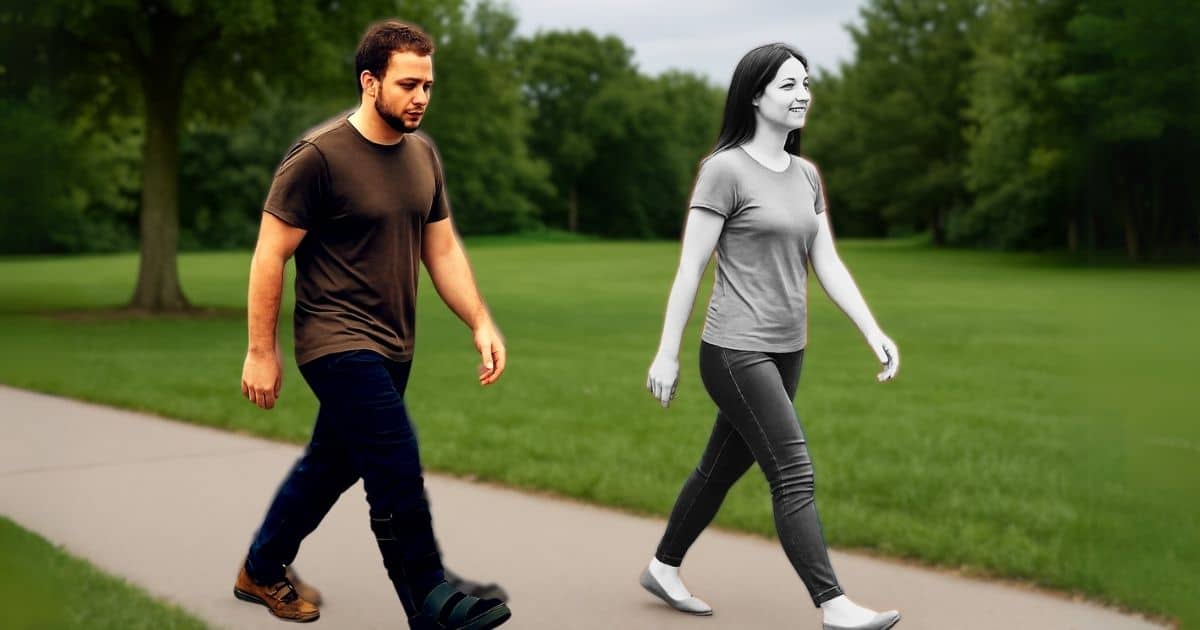When life gives you an opportunity to show the difference between a visible disability and an invisible one, you take it. My injured spouse was an eager participant. He knows about the frustrations of living with an invisible disability by watching my frequent struggles with communication access. Together, we made a video to highlight the difference.
Watching the video below, what do you see?
A man walking with a limp, wearing a boot that highlights his calf injury, followed by a woman moving easily down the same path. Who will attract more attention? Receive more offers of assistance?
The unsurprising answer came quickly as people started navigating around my husband to avoid bumping into him, and when the restaurant staff offered him a chair while we waited for our table.
Self-Advocacy Key for Invisible Disabilities
It’s just a fact. Someone with a visible disability is more noticeable, and is therefore more likely to receive help, whether solicited or not.
I didn’t need help walking down the path. Nor did my hearing loss friend need the wheelchair that arrived at the gate when she noted her hearing loss on a flight a few years ago. But when I do need communication access, I need to make it visible to others.
Here are some ways to do that.
1. Self-identify as a person with hearing loss
Not only does being open about hearing loss make communication easier, but it also takes the pressure off of having to hear everything perfectly. And what a relief that is!
A bonus: If people know we have trouble hearing, they are less likely to think we are rude or not paying attention to them if we mishear something or make an odd reply to a comment or question. They are more likely to simply try again.
2. Ask for what you need.
Self-identifying is not enough. People don’t understand hearing loss or know what they can do to be helpful. If we don’t provide options, they may resort to unhelpful behaviors like shouting or leaning in to whisper in our ear.
When we are as specific as possible about our communication requests—please face me and speak a little bit slower—it eases the path for both sides of the conversation.
3. Provide reminders.
Without a visual reference, it is easy for people to slip back into their normal patterns of speaking, which may not be as conducive to good conversation. Sadly, this can be true with friends and family just as much as with strangers. Reminders are needed.
Pro tip: Visual reminders like cupping your ear with your hand can be very effective and are often less disruptive than repeating verbal requests.
4. Stay positive
When we feel comfortable with our hearing loss, others do too. Use good humor if you miss something or when asking for repeats. When you do, others are more likely to comply with good humor as well. And don’t forget to laugh when hearing boo-boos occur. Some are hilarious.
5. Make the invisible more visible
Some people decorate their devices to make them more noticeable. Others wear buttons that proclaim their hearing loss or carry cards they can use for traffic stops or other face-to-face interactions. If this feels right for you, there are many options online.
6. Embrace education and advocacy.
Every time you ask a restaurant manager to lower the volume of the music or request a caption reader at a movie theater, you are helping the hearing loss community as a whole.
Educating others about how they can provide better communication access for you, creates an easier path for each person with hearing loss that follows.

Shari Eberts is a passionate hearing health advocate and internationally recognized author and speaker on hearing loss issues. She is the founder of Living with Hearing Loss, a popular blog and online community for people with hearing loss, and an executive producer of We Hear You, an award-winning documentary about the hearing loss experience. Her book, Hear & Beyond: Live Skillfully with Hearing Loss, (co-authored with Gael Hannan) is the ultimate survival guide to living well with hearing loss. Shari has an adult-onset genetic hearing loss and hopes that by sharing her story, she will help others to live more peacefully with their own hearing issues. Connect with Shari: Blog, Facebook, LinkedIn, Twitter.






